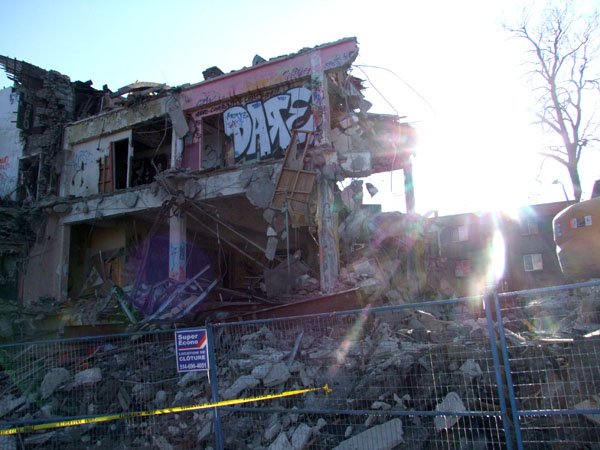A last-ditch attempt to s ave the building that housed the Negro Community Centre has failed.
ave the building that housed the Negro Community Centre has failed.
The fight for the historic building made its way into the justice system this month after a developer went straight to the courts to get permission to tear down the building at 2035 Coursol St. in Little Burgundy. While the Southwest Borough tried to stop the demolition, their effort proved fruitless.
Keeton Clarke, who spearheaded the effort to save the building, said receiving the news it would be torn down was “devastating.”
“Many people in the community have been connected to the building. I felt that loss would cause a great pain, h urt and disappointment for many Blacks in Montreal,” he said.
urt and disappointment for many Blacks in Montreal,” he said.
The Coursol St. building was built in 1891 and had previously served as a church before the NCC, founded in 1927, took it over in 1955. Ten years later, the centre was presented the deed to the building. The NCC provided programming for and services to the community, including sports and dance lessons, day camps for children, adult education courses and Christmas baskets.
The beginning of the end came in 1987, when a part of the back exterior wall collapsed. The centre’s members were forced to vacate in 1989 and the building has been empty since.
In the spring, another wall caved in, once again shedding light on the building’s dilapidated state. The NCC’s board, citing its “financial situation,” filed for bankruptcy in May.
A document prepared by a trustee at PricewaterhouseCoopers Inc. in July listed about $408,000 in assets, divided into about $239,000 in cash and $169,000 in property, a figure that corresponds with the city’s valuation of the Coursol St. building.
The document also lists about $166,000 in liabilities, all unsecured creditors.
The building was sold to a numbered company run by developer Paul Sen Chher in September. In Quebec’s business registry, Chher’s company is described as a e-commerce/Internet business operating out of building on Pine St. E.
Chher is also listed as the administrator of The Main Properties Inc., a property management company registered to the same address as the numbered company.
The borough had previously warned that it would not issue a demolition permit without seeing proof the developer’s plans for the building would preserve its structure.
On Friday, Nov. 14, a Quebec Superior Court justice ruled that the developer would be allowed to proceed with the demolition of the building, regardless of whether the borough would issue a permit, as early as the following Monday.
In court, Chher’s team argued the building was dangerous and that it would cost too much to fix.
The borough countered by filing a request at the Court of Appeal Monday, Nov. 17 to stay the first judge’s decision on the basis of the building’s historical significance to the Black community and that a city engineer had determined the building was not an imminent danger. Their request was denied the following morning.
The CONTACT left a message for Chher at a number listed under his name but had not heard back at press time.
Clarke said as the fight to save the building moved forward, the community’s interest in the cause was increasingly piqued.
“People became more concerned and interested in knowing what happened and knowing what’s next,” he said.
Gemma Raeburn-Baynes, who was also involved in the effort to save the building, hailed the community’s involvement in the cause.
“This is actually the first time in my 50 years in Canada I have seen the community come together as one for the support of one cause. Maybe we should continue to do this,” she said.
But not everyone was as congratulatory about the response.
“For too long the majority of the members of our community have been much too willing to defer leadership to the few, … without the burden of having to participate and (they feel) relieved of the need contribute time and effort to community building,” said Kenny Calder.
For now, the land the building sits on is not zoned for residential buildings, so razing the building in favour of condos area is not an option. Craig Sauve, the city councillor for the area, told the Gazette the borough would not change the zoning unless the developer comes up with a plan the community also endorsed. There was no mention of the possibility that the developer bypasses the city again and takes a possible rezoning request to the courts.
Clarke says he has been in contact with the developer, and that so far Chher has indicated that he is open to working with the community to create something on the land that all parties will be happy with.
His suggestions include having the façade of the building preserved and making the new building into a meeting space or hall where community members can gather, or putting together a museum or interactive exhibit where the history of the NCC and the building will be on display.
The community, Clark says, has to make sure it is in control of the memory of the centre and other institutions like it, such as the Black Studies Centre.
He points to his great-nephew, Daniel Clarke-Bouchard, a teenaged piano prodigy whose mother learned to play the piano at the NCC, to make his point – though the fight for the building itself is over, the NCC’s legacy will ensure it lives on.
The most important collective responsibility, he says, is that the community “remembers it and recalls it and passes it down to our children.”
Shame: The NCC is down and out for good












